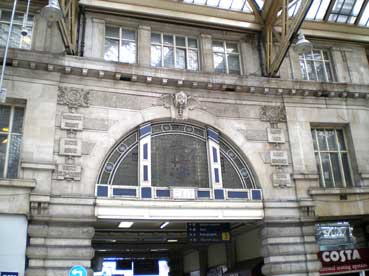 2008 images
2008 imagesWaterloo, one of the
great Southern Region London terminus stations (Victoria,
Charing
Cross,
London Bridge - a hybrid 'through' and terminus station, it is the
oldest
station in London, first opened in 1836). Waterloo is the UK's largest
station, covering an area of 24.5 acres. Inside the station, facing the
platform barriers, the large semicircular arch shown above carries
stonework banners on each side proclaiming the destinations served by
trains from Waterloo, each topped by a wreath enclosing the monogram
for the London & South Western Railway:
DORSET, SOMERSET
DEVON, CORNWALL' to the right. A winged cherubic head at the zenith of the arch seems to be flanked by a pair of railway wheels.
'L&S
W RY'
'HANTS,
WILTSW RY'
'MIDDLESEX,
SURREY
BUCKS, BERKS
SUSSEX, ISLE OF WIGHT' to the left,
BUCKS, BERKS
SUSSEX, ISLE OF WIGHT' to the left,
DORSET, SOMERSET
DEVON, CORNWALL' to the right. A winged cherubic head at the zenith of the arch seems to be flanked by a pair of railway wheels.

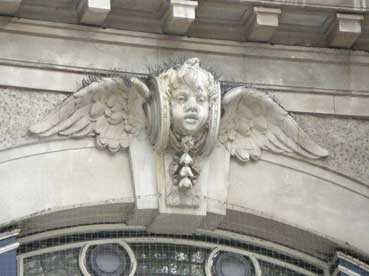
Outside the station, another semicircular arch: one of Waterloo's most notable features is the Victory Arch, built of Portland Stone. This commemorates the London and South Western and the Southern Railway men who gave their lives in the First and Second World Wars.
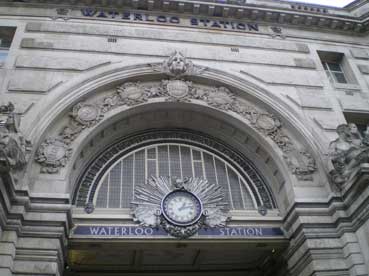
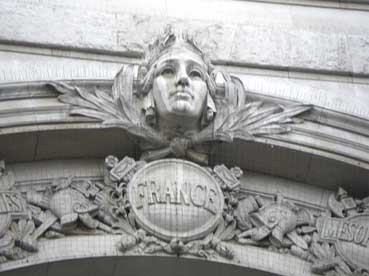
The lettering 'WATERLOO STATION' appears (attached to the stone facing) above the arch flanked by crowns and in white on blue ceramic either side of the central clock below. Running around the glazed section above the clock in condensed capitals of pierced silver metal: 'DEDICATED TO THE EMPLOYEES OF THE COMPANY WHO FELL IN THE WAR'.
On medallions grouped around the decorative frieze of the arch are the names of theatres of the Great War:
'BELGIUM... ITALY... DARDANELLES... FRANCE (below the central olive leaf-wreathed head)... MESOPOTAMIA... EGYPT... NORTH SEA'.
One remarkable feature is the clock at the radial centre of the archway. Surrounded by a sunburst of shards, with clouds below them, a swag of fruit below them, the clock face is topped by a military helmet and banner.
On the plinths of the statue groups on either side are the dates of "The War To End All Wars": '1914' to the left and '1918' to the right.
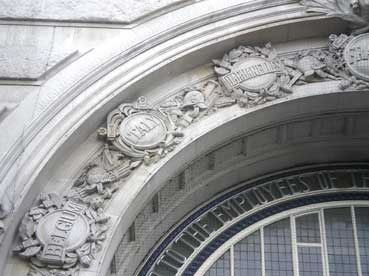

The original station was opened on 11 July 1848 by the London and South Western Railway. The Necropolis station (see below*) opened in October 1854 with the North station opening on 3 August 1860. The connection to the South Eastern Railway opened in January 1864. Waterloo Junction station (the present Waterloo East station) opened on 1 January 1869. The South station opened on 16 December 1878 and an additional North platform was added in November 1885. The Waterloo and City station opened on 8 August 1898 while the new Necropolis station opened on 16 February 1902. The South Eastern Railway connection was decommissioned on 26 March 1911. The station was completely rebuilt between 1900 and 1922 and had its official opening on 21 March 1922. The Necropolis station was bombed on 16 April 1941 but was not rebuilt.
The concourse underwent some remodelling work between 1978 and 1983. Platforms 20 and 21 were lost to the Waterloo International railway station site, which from 1994 until 13 November 2007 was the London terminus of Eurostar international trains. Construction necessitated the removal of decorative masonry forming two arches from that side of the station, bearing the legend "Southern Railway". This was re-erected at the private Fawley Hill Museum of Sir William McAlpine, whose company built Waterloo International. Waterloo International closed when the Eurostar service transferred to the astonishing, newly rebuilt St Pancras railway station: a Victorian cathedral of railways, indeed. The rather sad sight of the disused 'International' section of the station which seems to be bolted on to the main body of the building lies behind the cluttered and largely ignored sculpture of that great painter of the railways: Terence Cuneo: star of so many jigsaws, railway posters and carriage pictures of yore. Perhaps this section ought to be re-christened 'The New Necropolis Station' (see below).
The roof and platforms of the 1900 – 1922 station were designed by J. W. Jacomb-Hood and A. W. Szlumper, engineers for the LSWR. The roof is of transverse ridge and furrow construction and is 520ft by 540ft. The maximum single span is about 118ft. The office buildings were designed by J. R. Scott, the chief assistant architect for LSWR. It is in Imperial Baroque style and is notable for its Victory Arch. This was designed to commemorate the loss of LSWR servicemen during the First World War. It is constructed from Portland stone and carries statues depicting War and Peace, which are placed below a statue of Britannia.
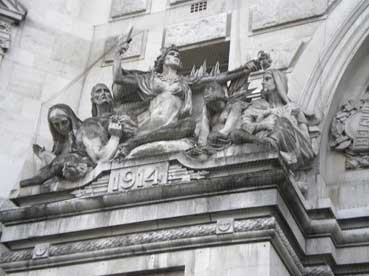
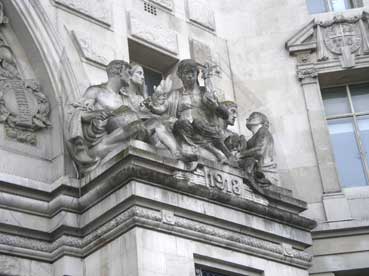
Waterloo Necropolis Station
*Brookwood Cemetery was opened in November 1854, and was the largest in the world. It was originally called the London Necropolis [literally 'city of the dead'] or Woking Cemetery. An unusual feature of Brookwood Cemetery was that it had its own private railway running through the grounds. The main reason for this was that the Cemetery was over 25 miles from central London, and the only convenient method of transporting coffins and mourners was by the London & South Western Railway. The funeral trains began to operate from 13 November 1854 when the Cemetery opened to the public.
A private Necropolis terminus was provided just outside Waterloo station. The original station (1854-1902) was located between York Street (now Leake Street) and the Westminster Bridge Road. This station was replaced by a more extensive building in 1902. This was due to the complete reconstruction of Waterloo Station. The original terminus was demolished at about this time. The new station was located at 121 Westminster Bridge Road and continued to provide railway funeral traffic until the station was bombed on the night of 16-17th April 1941. This entrance fascia at number 121 still exists and we clearly remember finding our way out of the main station via this access in the 1980s past the boarded-up remnants of the original booking windows with the lettering 'BOOKING OFFICE' above.
Below left: the now disused Necropolis station entrance.
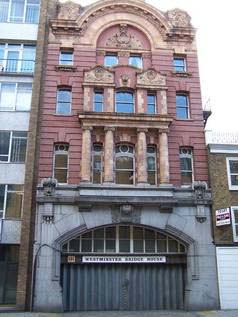
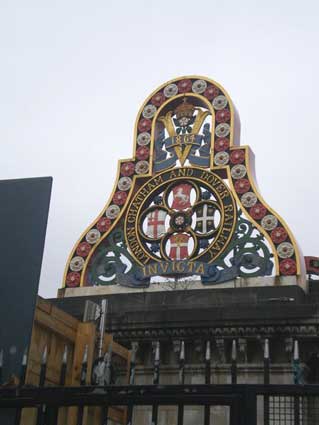
Above right: not far from Waterloo, as one walks down the river frontage and on the site of a demolished rail crossing over the Thames, next to the rather brutalist architecture of Doggett's Coat & Badge pub (now, inexplicably, a bar called 'Doggett's', thus at a stroke removing the link to the prize and name for the oldest rowing race in the world: up to six apprentice Watermen of the River Thames compete for this prestigious honour, which has been held every year since 1715), this fine piece of Victoriana in pierced cast iron:
'1864
LONDON CHATHAM AND DOVER RAILWAY
INVICTA'
'Invicta'
is Latin for unvanquished. The date wrapped
around the huge 'V' and Latin motto
float on scroll flourishes; the railway company name in a circle around
four armorial emblems. Thank goodness that London's refurbishment of
its riverside celebrates such a fine pair of decorative bridge
stantions. The bridge is 933 feet long, and had five spans of
wrought-iron lattice girders, supported by massive cast-iron columns.
The line was closed in 1964 and the superstructure removed in 1985,
leaving just the headless columns in the river and its decorative
insignia.
Engineer: Joseph Cubitt. Contractor: Kennards of Monmouthshire. The
columns can still be seen next to the present day Blackfriars Rail
Bridge.LONDON CHATHAM AND DOVER RAILWAY
INVICTA'
See also the Oxo Tower on this walk. Which isn't too far down the Southwark embankment from 'GABRIEL'S WHARF' which is hugely signed on a wall which also bears a trompe l'oeil run of painted windows. It can be seen on the riverside walk from The Cut, which is slightly south of Waterloo Sation, to Tate Modern (the former Bankside power station).
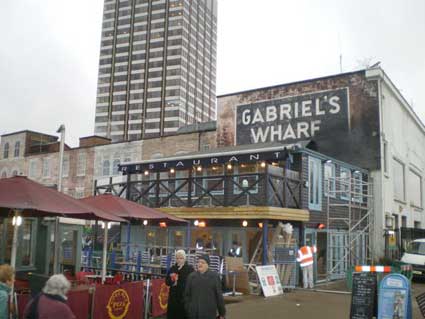 2012 photographs courtesy
David Gaylard
2012 photographs courtesy
David Gaylard Here are three images from sites around Waterloo.
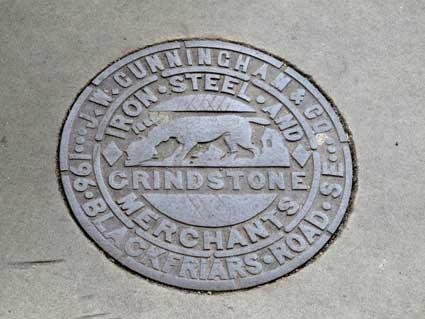
' ...J.W. CUNNINGHAM & CO...
196 BLACKFRIARS . ROAD . SE
IRON . STEEL . AND
GRINDSTONE
MERCHANTS'
Stamford Street coal hole cover. This
is apparently the last remaining 'dog and pot' coal
hole cover left which has not been stolen: it is set in concrete. 'Dog
and Pot' is an old pub name which Dickens noted.196 BLACKFRIARS . ROAD . SE
IRON . STEEL . AND
GRINDSTONE
MERCHANTS'

'WORKS ... 1846
... & MILLS'
The arched entrance with incised
characters is in in a row of early Victorian
houses in Balfe
Street (behind Caledonian Road)
in Kings Cross. The small, white painted '1846' date is in the
'keystone' in the centre. Described by one image collector as: "An
inviting archway [looking into the Regents Quarter] on the west side of
the street at number 17 leads into Albion Yard where blue, for washing
white clothes, was manufactured."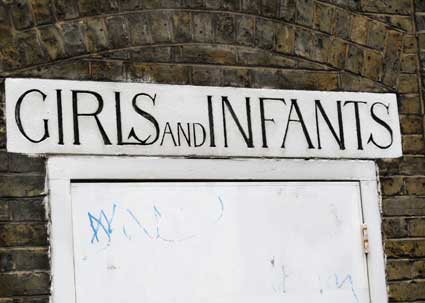
St Patrick's School, Secker Street near the junction with Cornwall Road is the location of the 'GIRLS & INFANTS' sign in vernacular font. We think we could call that intriguing overlap of 'L' and 'S' a kern. It has almost certainly be repainted in modern times.
Loughborough Junction station

2023 photograph courtesy David Gaylard
Loughborough Junction station in the Brixton area has clearly seen better days. This photograph shows the extensive graffiti on the brickwork. Attached to the wall, it looks as if a sheet of wood (or similar) bears the namestyle and slogan:
'snopake
[and] no mistake'
It is perhaps ironic that the second line has been
partially obliterated. The brand name wih its broken underline appears
here in high relief. The weathering has eaten away at the compound
used. This white-coloured correction fluid was one of a number of
brands which appeared on the market, notably in the 1970s and 80s in
the UK. Typists could white out an error, wait until the area was dry,
then type the correct character. There appears to be some discussion
about the origin of this, at one time, ubiquitous fluid. The most
persuasive explanantion One of the first forms of correction fluid was
invented in 1956 by American secretary Bette Nesmith Graham (mark the
middle name, gentle reader). Ms Graham continued experimenting with the
makeup of the substance until she achieved the perfect combination of
paint and several other chemicals. The refined product was renamed
'Liquid Paper' in 1958 and, amid soaring demand, Graham applied for a
patent and a trademark that same year. Bette
Nesmith Graham's son was, of course, Mike Nesmith – the tall dark one
from The Monkees. Excellent musician, songwriter and producer with the
First National Band and as a solo artist. When the Snopake patent
expired some time during the seventies, it enabled other similar
products to compete in the marketplace, which by then had entered into
the stationery field, and was welcomed by typists and office staff
generally. It is said that that the 'OP' in the Snopake logo is the
proof correction mark for deletion. That is exactly what the correction
fluid does – it covers or deletes mistakes. As far as we can discover,
this is the only wall advertisement for Snopake – and press
advertisements are thin on the ground, too. [and] no mistake'
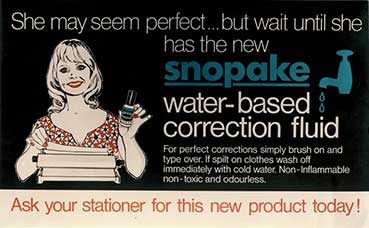 1960s(?) image
1960s(?) imageThe above example can be found on the Snopake/History web-page. We assume that it comes from the 1960s. Its visual and copywritten content complies absolutely with the woke, politically-correct mileu of 21st century media.
For further lettering examples see our London Galleries page.
Return to Historic Lettering from outside Ipswich
Please email any comments and contributions by clicking here.
Search Ipswich Historic Lettering
©2004 Copyright throughout the Ipswich Historic Lettering website: Borin Van Loon
No reproduction of text or images without express written permission